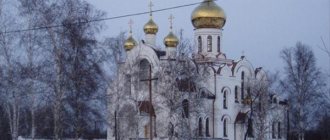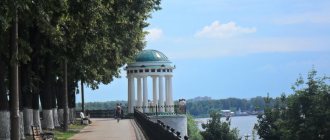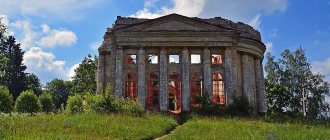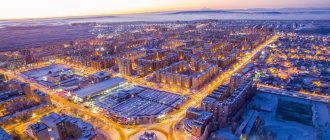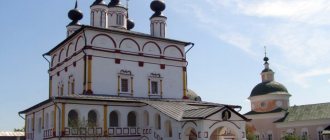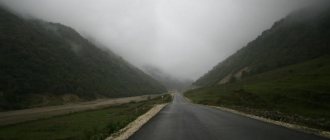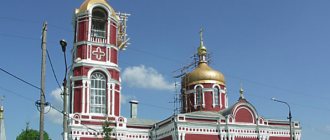Yuriev-Polsky
History of Yuryev-Polsky
Since ancient times, residents of Vladimir Opolye have been engaged in agriculture.
The fertile lands in the Koloksha Valley allowed them to grow grain and graze livestock. According to one version, it was active farming and large pastures that became the reasons for the appearance of vast forest-steppes here. In 1152, by the will of Moscow Prince Yuri Dolgoruky, a settlement was founded at a trade crossroads. It was named after Prince Yuri and its location - on the field, however, at first they wrote about the city “Gyurgev” or “Gergev”. Yuriev-Polsky grew quickly and by the beginning of the 13th century became the center of a small principality.
In 1238, Rus' was attacked by Mongol troops, and the city was severely devastated. Warlike nomads raided and devastated Russian lands several more times. The invasions of the khans Tokhtamysh (1382) and Edigei (1408) caused great damage to the city. In the 14th century, Moscow was chosen as the capital of the princely lands, and the role of Yuryev-Polsky noticeably decreased. For a long time it did not develop and turned into a quiet county town.
In 1968, one of the episodes of the film “The Golden Calf”, a film version of the novel of the same name by Ilya Ilf and Yevgeny Petrov, was filmed on the streets of the city. Old pre-revolutionary buildings and shopping arcades served as the backdrop for the city of Arbatov invented by the writers. After some time, “Golden Calf” became one of the tourist brands of Yuryev-Polsky, and today a cafe popular with tourists bears this name.
Monument to the founder of the city Yuri Dolgoruky
St. George's Cathedral
On May 1st Street, 100 meters from the city center, stands the white stone St. George's Cathedral. The first temple on this site was founded during the reign of Prince Yuri Dolgoruky. It existed for only half a century and, according to the chronicles, was destroyed during a strong earthquake. When this happened, the reigning prince Svyatoslav Vsevolodovich ordered to dismantle the stone ruins and build a new cathedral.
St. George's Cathedral was built in 1234. It was distinguished by rich white stone carvings. The walls of the temple were covered with images of animals, birds and Christian saints. Together with the ornament, they made up pictures connected by a common plot.
St. George's Cathedral
By the middle of the 15th century, St. George's Cathedral had become dilapidated and partially collapsed. The Grand Duke of Moscow Ivan III Vasilyevich, having learned about this, ordered the immediate restoration of the shrine. The famous architect from Moscow Ermolin undertook to restore the temple. There were no stone quarries near Yuryev-Polsky, so the builders had to erect collapsed walls from old stones. The temple turned out to be lower, but it became much stronger. The boundary between new and old masonry is clearly visible even today. Placed in the 15th century, the stones run diagonally from top to bottom, from the northwest corner of the building.
In the 17th century, a tented bell tower was erected near the cathedral. Then it was replaced with a four-tier one. And in the 19th century, a warm Church of the Exaltation of the Cross appeared near the cathedral. Later, several restorations of St. George's Cathedral took place, during which the bell tower and later temple extensions were dismantled.
The single-domed cathedral has a cubic quadrangle and three semicircular apses. A massive dome with a cross rests on a squat light drum. The northern portal is better preserved than others and looks great. Previously, it overlooked the main square of Yuryev-Polsky.
On the walls of the cathedral you can see images of Christ, St. George the Victorious, holy warriors - patrons of the Vladimir princes, lions, a centaur, peacocks and intricate floral patterns. Most of the carved white stone bas-reliefs form a single plot, but some are located separately. This discrepancy appeared after restoration work in the 15th century. Medieval builders used stones from a collapsed building and some of them were placed in random order.
The carved elephant should be found on the northern façade. It is located above a column topped with a woman's head. To see the elephant, it is advised to move a little away from the cathedral, and then it will not be covered by the lower bas-reliefs.
Where did the image of the elephant in Yuryev-Polsky come from? The carvers who worked in Ancient Rus' could see it only on the pages of manuscripts. If you look closely, the image on St. George's Cathedral is not an elephant, but a mythological animal. The trunk and tusks are those of an elephant, the ears are those of a hare, and the limbs are those of a bird.
Nowadays, services in the temple are rarely held. The rest of the time it is open to tourists as a museum. Samples of ancient Russian white stone carvings are displayed inside. Here is also the “Svyatoslav Cross”, which was made by order of the ancestor of the Yuryev princes - Svyatoslav Vsevolodovich (1196-1252).
Michael the Arkhangelsk Monastery
To the north of St. George's Cathedral, closer to the center of Yuryev-Polsky, lies the territory of the monastery. The buildings of the Michael-Arkhangelsk monastery stand in a ring of powerful earthen ramparts and fortress walls, so they look like a Kremlin. The monastery was founded in the 13th century by the son of Vsevolod the Big Nest - Prince Svyatoslav. Initially, its churches and cells were wooden, and when the Mongol troops attacked Rus', they easily burned the monastery.
Yuriev-Polsky survived more than one invasion of the Horde, so for about two centuries they did not even try to restore the monastery. Changes came only in the 16th century, when a stone wall and towers were built instead of a wooden palisade. The first stone temple appeared here in 1560. It was erected with the money of Prince Ivan Mikhailovich Kubensky. We don’t know what this church looked like, because it has not been preserved.
Michael-Arkhangelsk monastery was considered rich. She received many gifts from Prince Dmitry Mikhailovich Pozharsky, whose estate was located not far from Yuryev-Polsky, in the village of Bolsheluchinskoye.
Today the monastery is a beautiful architectural ensemble consisting of buildings from the 17th-18th centuries. It has a small but very well-groomed territory on which exhibitions of the local history and art museum are located. At the same time, a monastic community lives here, and church services are regularly held in the temples. Near the monastery there is a monument to the founder of Yuryev-Polsky, Prince Yuri Dolgoruky.
The central place in the monastery is occupied by the Archangel Michael Cathedral. The five-domed temple was built at the turn of the 18th-19th centuries with money raised by the residents of Yuryev-Polsky. The cathedral is richly decorated with rustication, cornices and carved friezes. The icon of Archangel Michael is kept here, which, together with the soldiers of the 5th regiment of the Vladimir militia, marched along the roads of the Patriotic War of 1812-1814.
Michael the Archangel MonasteryTo the north-west of the cathedral rises a beautiful multi-tiered bell tower of the 18th century. The slender octagonal building is decorated on all sides with carved ornaments, and three rows of “rumors” are installed on the top of the tent.
To the south of the cathedral stands the Church of the Sign, which appeared in 1625. The low, single-domed temple has a spacious refectory. Its first floor is used for economic purposes, and covered passages lead to the archimandrite and fraternal buildings.
From the west, the monastery territory is limited by a section of the fortress wall with towers. These fortifications were built in the middle of the 16th century. The Church of St. John the Theologian, built in 1670, rises above the gate leading to the monastery. The five-domed temple has a wide cornice and its architecture echoes the Archangel Michael Cathedral.
Near the bell tower you can see a small overhead chapel and the Church of St. George the Victorious, brought here from the village of Yegoriy. They were built at the beginning of the 18th century for the St. George Monastery and moved to Yuryev-Polsky in 1968. The chapel and church are excellent examples of Russian wooden architecture. They are very beautiful and fit organically into the architectural ensemble of the monastery.
Museums of Yuryev-Polsky
Museum exhibitions occupy the buildings of the Archangel Michael Monastery, on 1 May Street, 4. The main section of the museum is dedicated to the history of the peasantry and agriculture of the Vladimir region. The items collected here allow you to get acquainted with the customs and traditions of the inhabitants of Yuryev-Polsky, starting from ancient times. The display cases display jewelry found by archaeologists, chain mail, a fragment of a mica window, and fossilized rye from the 11th century. In the halls you can see a collection of barn locks, a Russian stove and the interiors of peasant dwellings.
One of the sections of the museum tells about the life of the Russian commander Pyotr Ivanovich Bagration. The central place in it is occupied by the carriage in which the seriously wounded Bagration was brought to the village of Sima near Yuryev-Polsky after the Battle of Borodino. Here he died and was buried in the family crypt of the Golitsyn princes.
In the arch under the passage that connects the Church of the Sign and the archimandrite building, there is an exhibition of carved platbands. Beautiful wooden frames were brought to the museum from villages located near Yuryev-Polsky. Skillful products of local craftsmen also hang on the walls of the church and fraternal building.
On the second floor of the archimandrite building there is an exhibition introducing visitors to the history of the development of the weaving manufactory in Yuryev-Polsky. Beautiful tiled stoves, spindles, spinning wheels, samples of printed fabrics and sewing machines are on display here. And the interiors are decorated with modern tapestries made by the hands of the masters of the Avangard weaving factory.
One of the museum exhibitions is located in a high tented bell tower. On the ground floor of the building a monastic cell is shown. On the second floor there is an exhibition dedicated to bell ringing, and even higher there is an excellent observation deck. Tourists climb it to admire the monastery and the central streets of Yuryev-Polsky. At the entrance, the bell tower has a small door, the height of which is only 2/3 of the average height of a person. Only small children can pass through it without bending.
If you go up to the second floor of the Gate Church of St. John the Evangelist, you can see an art exhibition. It displays icons of the 16th-19th centuries, paintings by the Itinerant artists and a collection of old porcelain. Most of the porcelain items came to the museum from the Golitsyn family estate. The most interesting exhibits are the original floor vases.
The museum doors are open to visitors on any day except Tuesday. On Mondays it is open from 9.00 to 15.00, and on other days from 9.00 to 17.00. Please note that the ticket office closes an hour earlier.
Ancient temples
Not far from the monastery there is a temple complex, which consists of two churches - Pokrovskaya and Nikitskaya. The first was built in 1769, and the second in 1799. Adjacent to the snow-white, five-domed Church of the Intercession of the Virgin Mary is a four-tiered bell tower - the tallest building in Yuryev-Polsky. Through it, believers get inside the Church of the Intercession.
The one-domed Nikitsky Church is small in size. It was built in the traditions of classicism and decorated on four sides with triangular pediments and snow-white columns. The walls of the church are painted in contrasting colors, brick and white. The temple complex is surrounded by a beautiful wrought iron fence and looks very harmonious.
At 6 Avangardny Lane, there is a snow-white Church of the Nativity of Christ. It was built in the 18th century on the site of a dilapidated wooden church. The Cold Church is notable for its six domes. In the 1930s, it, like most of the churches in Yuryev-Polsky, was closed, and printing presses and dairy plant equipment were placed in the premises. Then the church was restored, and now it is functioning.
Where to stay
Most travelers come to Yuryev-Polsky for one-day excursions. But those who want to stay here longer can stay at one of the city hotels. All of them are located in the city center and provide approximately the same range of services.
The hotel accommodates not only business travelers (Zavodskaya St., 1A). On weekends many tourists stop here. There is no cafe or dining room in this hotel, but guests can prepare their own food using a microwave oven, kettle, stove and utensils.
On Vladimirskaya Street, 22 there is a small hotel “Pokrovskaya”. Breakfast is included when staying, and suites have separate kitchenettes with a microwave, dishes and a kettle.
On Sovetskaya Square there is the Yuryevskaya Hotel. Its guests receive not only rooms, but also breakfast. Conveniently, right next to the hotel there is a cafe, “Golden Calf”, popular among city guests.
Mini-hotel "Pearl" is probably the most inexpensive in Yuryev-Polsky. It offers travelers four neat rooms. The hotel is located on Shibankova Street, 72, just a 5-minute walk from the city center.
Booking.com
How to get there
Yuryev-Polsky is located in the north-west of the Vladimir region, 180 km from Moscow. The nearest international airport is in Ivanovo. The journey by car from Moscow to Yuryev-Polsky takes about 3 hours and passes through Kirzhach and Kolchugino along the A-105 highway.
The railway station is located 1.5 km south of the city center. A line runs through it from Aleksandrov to Ivanovo, along which several long-distance trains, as well as two electric trains, run daily. You can get from Moscow to Yuryev-Polsky in 4.15-4.50 hours by trains that go to Kineshma and Ivanovo.
There is a city bus station next to the railway station. Regular buses come here from Vladimir, Alexandrov, Pereslavl-Zalessky and Moscow. From the capital's bus station, which is located near the Shchelkovskaya metro station, 3-4 buses go to Yuryev-Polsky every day. The journey to the city takes 4 hours.
Administrative subordination includes:
Cities:
- City of Yuryev-Polsky
Villages:
- Village Bildino
- Borisovka village
- Village Vasilyevka
- Veska village
- Vizhegsha village
- Village Voskresenskoye
- Village of Vypolzovo
- Village Gavriltsevo
- Village Dergaevo
- Village Drozdovo
- Village Egorovka
- Yelokh Village
- Village Zhelezovo
- Village Zventsovo
- Village Karabanikha
- Village Karandyshevo
- Village Klyuchevaya
- Village Knyazhikha
- Village Kolenovo
- Village Kolokoltsevo
- Village Lazarevskoye
- Village Lukino
- Village Markovo
- Village Makhlino
- Mihali village
- Village Mukino
- Village Nevezhino
- Village Novaya
- Village Novopavlovka
- Osipovets village
- Ryabinki village
- Sluda village
- Village Starkovo
- Tereshki village
- Village Teslovo
- Village Tursino
- Village Turygino
- Village Khoroshovka
- Chuvashikha village
- Village Shadrino
- Village Yurkovo
- Baskaki village
- Village Elkhovskoe forestry
- Kokorekino village
- Village Malo-Petrovskoye
- Village Tartyshevo
- Terentyevka village
- Shegodskaya village
- Petryatkovo village
Place:
- The town of Lucky
- Shordoga town
Villages:
- Ababurovo village
- Avdotyino village
- Village Aleksino
- Andreevskoe village
- Andreevskoe village
- Village Afineevo
- Belyanitsyno village
- Berezniki village
- Village Bogdanovskoye
- Village Bogorodskoye
- Bolsheluchinskoe village
- Bolshepetrovskoe village
- Village Varvarino
- Volstvinovo village
- Gorki village
- Village Gorodishche
- Village Goryainovo
- Village Grigorovo
- Village Dobrynskoye
- Village Dubrava
- Village Zaborye
- Village Ivorovo
- Village Ilyinskoye
- Village Inalovo
- Village Kalinovka
- Village Karelskaya Slobodka
- Village Brick Factory
- Village Kosinskoye
- Village Kotluchino
- Krasnaya Gorka village
- Village Krasnoe
- Village of Krasnoye Zarechye
- Village Kubaevo
- Village Kuzmadino
- Village Kumino
- Village Kuchki
- Village Lednevo
- Village Deciduous
- Village Lykovo
- Maloluchinskoe village
- Village Matveyshevo
- Nebyloe village
- Village Nenashevskoye
- Village Nesterovo
- Nikulskoe village
- Village Novoe
- Ozerny village
- Village Opolye
- Village Pavlovskoye
- Village Palazino
- Village Parsha
- Penye village
- Village Podlesny
- Village Podolets
- Village Poelovo
- Village Prechista Gora
- Village Prigorodny
- Village Rucheiki
- Village Ratislovo
- Village Ryabinino
- Village Svaino
- Village Simizino
- Village Seminskoye
- Village Sima
- The village of Soroguzhino
- Sosnovy Bor village
- The village of Spasskoye
- Village Starnikovo
- Tenki village
- Village Ternovka
- Fedorovskoe village
- The village of Fedosino
- Village Frolovskoye
- Village Khvoyny
- Village Chekovo
- Village Cherkasovo
- Shegodskoe village
- Village Shipilovo
- Village Shikhobalovo
- Village Enthusiast
- Village Bogdanovsky fish hatchery
- Vorogovo village
- Village Yeltsy
- Village Isakovo
- Kalman village
- Village Kosagovo
- Village of Maymor
- Village Parkovy
- Village of Peremilovo
- Village of Radovanie
- Village Starkovo
- Village Turabyevo
- Fedorovskoe village
- Village Chernokulovo
- Village Kamenka
